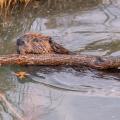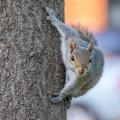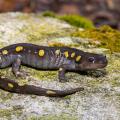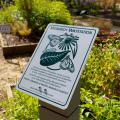Urban and Backyard Wildlife
Creating a landscape to attract wildlife is a goal of many homeowners. As natural areas for wildlife have decreased because of urbanization, more and more homeowners are realizing there is more to a landscape than a sterile arrangement of plants. It can and should be a vibrant mix of elements in which critters, plants, and humans happily coexist. Many people envision gaily-colored butterflies and birds feeding and flitting about the yard. That is the more visible aspect of a backyard habitat. Striving for biodiversity in the backyard that includes less noticed and less appreciated critters increases the sustainability of your habitat and your enjoyment of the area. Many insects, spiders, reptiles, amphibians, and even small mammals can keep habitat populations of pests in check. Letting these critters live together with the more showy butterflies and birds helps keep the “undesirables” like flies, mosquitoes, slugs, rodents, and other creatures balanced within your habitat. Designing a balanced habitat encourages a diverse population that provides a natural system of checks and balances.
THREE BASIC NEEDS OF WILDLIFE
Creating your backyard habitat can be very easy once you understand that wildlife, just like people, have three basic needs. These needs—food, water, and cover—promote use and provide the lifecycle needs of wildlife. A successful backyard habitat must include all three needs. It takes only a small investment of time to make your yard or garden “wildlife friendly” by adding these essentials.
- FOOD – You can provide food in two ways.
- Artificial feeding—bird feeders, squirrel feeders, and such.
- Natural vegetation—planting a variety of native trees, shrubs, grasses, and flowering plants that provide nuts, seeds, nectar, fruit, and other sources of nourishment. Providing food through natural vegetation is preferred. It tends to encourage the “natural feeding mechanism” wildlife uses. It does not congregate animals, which leads to several problems, including spread of disease, and it provides a seasonal approach that is enjoyable from a gardening and recreational wildlife standpoint. This will encourage a wider range of creatures already used to using these plants. Using natural vegetation, compared to providing artificial feed, is less costly over time and is easier to maintain. After all, you may forget to keep those feeders full of food! Remember, including plants that provide foraging opportunities in the winter offers an almost year-round supply of food. Refer to the plant list on page 15 for more information about winter food.
- WATER – Providing water for both drinking and bathing is vital to wildlife. You can include it by having birdbaths, drippers, or small ponds. Garden ponds that are large enough to include water animals (fish, frogs, toads, salamanders, snails) as well as water plants add beneficial elements that complement most backyard habitat settings. Surrounding the pond with plants adds to the attraction for wildlife. Be sure the water source is dependable year-round.
- SHELTER/REPRODUCTIVE AREAS —Nesting and shelter areas where wildlife are protected from the weather and predators is essential. Various species require different landscape features for these needs. Providing a diversity of plant material that includes evergreen and deciduous trees, vines, shrubs, herbaceous plants, grasses, and ground covers lets wildlife select the right areas for their feeding, nesting, and shelter needs. Ideal habitats include plants of various sizes, densities, and types. Evergreens are particularly valuable for winter cover. Grouping plants close to sources of food and water provides the cover wildlife need to feel safe while feeding or drinking. Of course, proper selection of plants includes those that provide food as well as good cover and nesting. Living plants are only one way to provide shelter and nesting areas. Using bat houses, bird houses, toad houses, and other artificial shelters is an easy way to meet this basic need. Providing shelter areas is especially valuable if you have a new landscape where trees and shrubs are not large enough to provide the necessary habitat. Old tree stumps, fallen logs, and brush and rock piles can also provide a great habitat for wildlife. Learning to appreciate these features (the dead tree snag or the pile of brush) for their natural artistry and wildlife benefits is helpful when creating the backyard habitat.
EkoKids: Schoolyard Nature Guides
Publications
News
Have you ever been on a walk in the woods, park, or backyard and noticed animal tracks in the mud or dirt? Some tracks are easy to identify, while others are a bit harder to tell which animal they belong to.
Have you ever been on a walk in the woods, park, or backyard and noticed animal tracks in the mud or dirt? Some tracks are easy to identify, while others are a bit harder to tell which animal they belong to. It’s a fun guessing game trying to figure out which animal has been visiting nearby.
The yellow-spotted salamander is a slippery, shiny Mississippi amphibian. Also known as Ambystoma maculatum, this is a large amphibian, measuring between six to nine inches!
Success Stories
See what's new in Extension: a new monarch garden, a storytelling series will begin, the Garden Expo highlights Extension education, and Keep America Beautiful recognizes MSU Extension.






